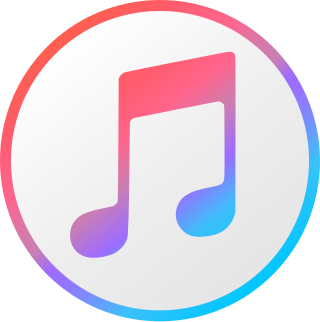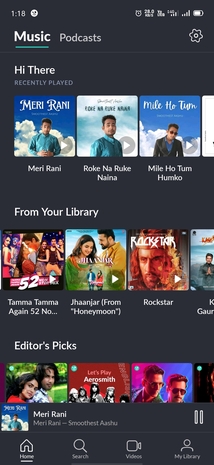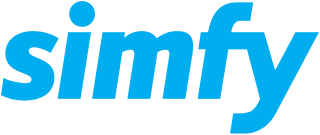
Streaming media refers to multimedia for playback using an offline or online media player that is delivered through a network. Media is transferred in a "stream" of packets from a server to a client and is rendered in real-time; this contrasts with file downloading, a process in which the end-user obtains an entire media file before consuming the content. Streaming is presently most prevalent in video-on-demand, streaming television, and music streaming services over the Internet.

iTunes is a software program that acts as a media player, media library, mobile device management utility, and the client app for the iTunes Store. Developed by Apple Inc., it is used to purchase, play, download and organize digital multimedia on personal computers running the macOS and Windows operating systems, and can be used to rip songs from CDs as well as playing content from dynamic, smart playlists. It includes options for sound optimization and wirelessly sharing iTunes libraries.

A playlist is a list of video or audio files that can be played back on a media player, either sequentially or in a shuffled order. In its most general form, an audio playlist is simply a list of songs that can be played once or in a loop. The term has several specialized meanings in the realms of television broadcasting, radio broadcasting and personal computers.
Pandora is a subscription-based music streaming service owned by the broadcasting corporation Sirius XM Holdings that is presently based in Oakland, California inside of the United States. The service carries a focus on recommendations based on the "Music Genome Project", which is a means of classifying individual songs by musical traits such as genres and shared instrumentation. The service originally launched in the consumer market as an internet radio service that would generate personalized channels based on these traits as well as specific tracks liked by the user; this service is available in an advertising-supported tier and additionally a subscription-based version. In 2017, the service launched Pandora Premium, which is an on-demand version of the service more in line with contemporary competitors.

Content marketing is a form of marketing focused on creating, publishing, and distributing content for a targeted audience online. It is often used by businesses in order to achieve the following goals: attract attention and generate leads, expand their customer base, generate or increase online sales, increase brand awareness or credibility, and engage an online community of users. Content marketing attracts new customers by creating and sharing valuable free content as well as by helping companies create sustainable brand loyalty, providing valuable information to consumers, and creating a willingness to purchase products from the company in the future.

JioSaavn is an Indian music streaming service and a digital distributor of Hindi, Marathi, English, Malayalam, Bengali, Kannada, Tamil, Telugu, Bhojpuri, Punjabi, Chhattisgarhi and other regional languages of India. Since it was founded in 2007 as Saavn, the company has acquired rights to over 80 million music tracks in 16 languages. JioSaavn is a freemium service; basic features are free with advertisements or limitations, while additional features, such as improved streaming quality and music downloads for offline listening, are offered via paid subscriptions.
Deezer is a French music streaming service founded in 2007. The company has been a subsidiary of Access Industries since 2016. Deezer is available via web and on various digital platforms, including Android, iOS, macOS and others.
Spotify is a Swedish audio streaming and media service provider founded on 23 April 2006 by Daniel Ek and Martin Lorentzon. It is one of the largest music streaming service providers, with over 615 million monthly active users, including 239 million paying subscribers, as of March 2024. Spotify is listed on the New York Stock Exchange in the form of American depositary receipts.
A music streaming service is a type of online streaming media service that focuses primarily on music, and sometimes other forms of digital audio content such as podcasts. These services are usually subscription-based services allowing users to stream digital copyright restricted songs on-demand from a centralized library provided by the service over the internet. Some services may offer free tiers with limitations, such as advertising and limits on use. They typically incorporate a recommender system to help users discover other songs they may enjoy based on their listening history and other factors, as well as the ability to create and share public playlists with other users. It may also include customized radio or social media platforms.

SoundCloud is a German audio streaming service owned and operated by SoundCloud Global Limited & Co. KG. The service enables its users to upload, promote, and share audio. Founded in 2007 by Alexander Ljung and Eric Wahlforss, SoundCloud is one of the largest music streaming services in the world and is available in 190 countries and territories. The service has more than 76 million active monthly users and over 200 million audio tracks as of November 2021. SoundCloud offers both free and paid memberships on the platform, available for mobile, desktop and Xbox devices. SoundCloud has evolved from a traditional online streaming platform to an entertainment company.

Simfy Music was a music subscription service available in Germany, Austria, and Switzerland, It was available as a website and also had clients for iPhone, Android, and BlackBerry which can play streaming music or cache songs for offline playback. The web-based service also offered a cross-platform client based on Adobe Air. Its library had content from the four major record labels, as well as the Merlin Network and aggregators such as The Orchard, and Finetunes. Simfy also offered social networking, allowing users to share playlists and follow others to see what music they listen to. In June 2014, MTN partnered with Simfy for streaming music

8tracks.com is an internet radio and social networking website revolving around the concept of streaming user-curated playlists consisting of at least 8 tracks. Users create free accounts and can browse the site and listen to other user-created mixes, as well as create their mixes. The site also has a subscription-based service, 8tracks Plus, although this is currently only available to listeners based in the United States and Canada.

Moodagent is a white label music streaming service that specializes in interactive playlists and personalized music recommendations. The Moodagent brand is developed and owned by the Danish company Moodagent A/S, which has proprietary methods for recognizing emotional and musical characteristics of individual tracks.

Tomahawk was a free, open-source cross-platform music player for Windows, macOS and Linux. An Android beta client version was launched in June 2016. It focuses on the conglomeration of the user's music library across local and network collections as well as streaming services. The project was marked as abandoned by their authors on May 10, 2017.
Apple Music is an audio and video streaming service developed by Apple Inc. Users select music to stream to their device on-demand, or they can listen to existing playlists. The service also includes the sister internet radio stations Apple Music 1, Apple Music Hits, and Apple Music Country, which are broadcast live to over 200 countries 24 hours a day. The service was announced on June 8, 2015, and launched on June 30, 2015. New subscribers get a one-month free or six months free trial with the purchase of select products before the service requires a monthly subscription.

Joox is a music streaming service owned by Tencent, launched in January 2015. Joox is the biggest music streaming app in Asian markets such as Hong Kong, Macau, Indonesia, Malaysia, Myanmar, Thailand and also in South Africa before it was shut down in early 2022. Joox is a freemium service, providing most of its songs free, while some songs are only available for premium users, offered via paid subscriptions or by doing different tasks offered.
Spotify, a music streaming company, has attracted significant criticism since its 2006 launch, mainly over artist compensation. Unlike physical sales or downloads, which pay artists a fixed price per song or album sold, Spotify pays royalties based on the artist's "market share"—the number of streams for their songs as a proportion of total songs streamed on the service. Spotify distributes approximately 70% of its total revenue to rights holders, who then pay artists based on their individual agreements. Multiple artists have criticised the policy, most notably Taylor Swift and Thom Yorke, who temporarily withdrew their music from the service.
How Bad Is Your Spotify?, also known as How Bad Is Your Streaming Music? and "Judge my Spotify", is an internet bot created by Matt Daniels of digital publication The Pudding that will roast users based on the contents of their Spotify library.
Spotify Kids is a mobile app that allows children to browse Spotify while providing their parents with parental controls. The app also includes curated content for children such as audiobooks, lullabies, and bedtime stories. Only subscribers to Spotify's Premium Family subscription plan can access the app, which has been described as a method of boosting subscriptions to the plan.











